欧洲文化入门
欧洲文化入门中文版课件
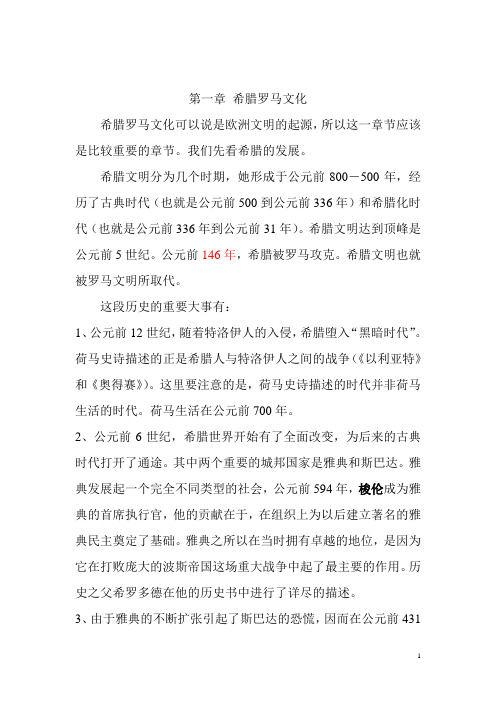
第一章希腊罗马文化希腊罗马文化可以说是欧洲文明的起源,所以这一章节应该是比较重要的章节。
我们先看希腊的发展。
希腊文明分为几个时期,她形成于公元前800-500年,经历了古典时代(也就是公元前500到公元前336年)和希腊化时代(也就是公元前336年到公元前31年)。
希腊文明达到顶峰是公元前5世纪。
公元前146年,希腊被罗马攻克。
希腊文明也就被罗马文明所取代。
这段历史的重要大事有:1、公元前12世纪,随着特洛伊人的入侵,希腊堕入“黑暗时代”。
荷马史诗描述的正是希腊人与特洛伊人之间的战争(《以利亚特》和《奥得赛》)。
这里要注意的是,荷马史诗描述的时代并非荷马生活的时代。
荷马生活在公元前700年。
2、公元前6世纪,希腊世界开始有了全面改变,为后来的古典时代打开了通途。
其中两个重要的城邦国家是雅典和斯巴达。
雅典发展起一个完全不同类型的社会,公元前594年,梭伦成为雅典的首席执行官,他的贡献在于,在组织上为以后建立著名的雅典民主奠定了基础。
雅典之所以在当时拥有卓越的地位,是因为它在打败庞大的波斯帝国这场重大战争中起了最主要的作用。
历史之父希罗多德在他的历史书中进行了详尽的描述。
3、由于雅典的不断扩张引起了斯巴达的恐慌,因而在公元前431年爆发了伯罗奔尼撒战争。
战争最终以雅典的失败而告终。
修昔底得这位历史上最伟大的历史学家在其作品中,详尽描写了这一战争。
4、伯罗奔尼撒战争后,斯巴达专横跋扈,底比斯和雅典为求相互保护而结成新的联盟。
公元前371年,马其顿国王腓力二世打败了底比斯和雅典联军,他的闻名世界的儿子亚历山大大帝统治了希腊。
至此,古典时代结束,希腊化时代即将开始。
古典时代的希腊造就了一批哲学家和剧作家。
哲学家主要以苏格拉底、柏拉图和亚里士多德为代表。
苏格拉底提出自由辩论的重要性。
柏拉图的目标是要实现一个既能维持贵族特权,又可为贫苦阶级接受的社会,并构件了唯心主义的根基。
亚力士多德寻求自然界和人类社会各个方面的秩序。
欧洲文化入门(英文课件

历史性:欧洲文 化具有悠久的历 史,从古希腊、 罗马到中世纪、 文艺复兴等时期 都有丰富的文化 遗产
创新性:欧洲文 化具有创新性, 如文艺复兴、启 蒙运动等时期都 推动了人类文明 的进步
影响力:欧洲文 化对全球产生了 深远的影响,如 科学、哲学、艺 术、文学等领域 都产生了重要的 影响
欧洲文化的代表人物和事件
欧洲哲学的思想体系和代表人物
古希腊哲学:苏格拉底、柏拉图、亚里士多 德
启蒙运动时期哲学:伏尔泰、卢梭、康德
中世纪哲学:奥古斯丁、托马斯·阿奎那
德国古典哲学:黑格尔、费尔巴哈、马克思
文艺复兴时期哲学:笛卡尔、培根、霍布斯
现代哲学:尼采、萨特、海德格尔
欧洲历史和哲学的文化内涵和影响
欧洲历史:从古希腊罗马到中世纪, 再到文艺复兴和启蒙运动,欧洲历 史经历了多次变革和进步
欧洲宗教的信仰体系和仪式
东正教:基督教的另一个分支, 强调教会的独立性和传统
新教:基督教的另一个分支, 强调个人信仰和圣经的权威
天主教:基督教的一个分支, 强调教会的权威和传统
仪式:洗礼、婚礼、葬礼等, 都是欧洲宗教的重要仪式
基督教:欧洲最主要的宗教, 信仰上帝和耶稣基督
节日:圣诞节、复活节、万圣 节等,都是欧洲宗教的重要节
欧洲旅游的重要景点和特色
罗马斗兽场:意大利罗马的古 代建筑,可以了解古罗马的历 史和文化
卢浮宫:法国巴黎的著名博物 馆,收藏了大量的艺术品和历 史文物
埃菲尔铁塔:法国巴黎的标志 性建筑,可以俯瞰整个巴黎市 区
威尼斯水城:意大利威尼斯的 水上城市,可以体验独特的水
上生活
巴塞罗那高迪建筑:西班牙巴 塞罗那的建筑,可以欣赏到高
欧洲艺术和音乐在欧洲历史上扮演了重要的角色,如文艺复兴时期、巴洛克时期、古典主义时期等,这些时期的 艺术和音乐对欧洲文化的发展产生了重要的影响。
《欧洲文化入门》试题及重点内容归纳总结(完整版)

《欧洲文化入门》第一部分试题I. Choose the most appropriate one for the following blanks.1 . Two maj or elements in European culture are ____.A. the Greek and RomanB. the Judaism and ChristianityC. the Greco-RomanD. A and B2. ____ deals with the Troj an War (the Greek states led by Agamemnon in their war against the city of Troy ).A. The OdysseyB. The IliadC. Prometheus BoundD. Persians3. The play Prometheus Bound was written by _____.A. AeschylusB. AristophanesC. EuripidesD. Sophocles4. The best writer of comedy of the ancient Greece was ____ , who is Father of Comedy.A. EuripidesB. AristophanesC. SophoclesD. Aeschylus5. ____ was one of the earliest exponents of the atomic theory.A. HomeB. HeracleitueC. DemocritusD. Socrates6, ____by Plato is a book about the ideal state ruled by a philosopher but barring poets.A. DialoguesB. The ApologyC. The RepublicD. Symposium7. Dante called ____ “ the master of those who know”.A, Aristotle B. Plato C. Socrates D. Archimedes8. Euclid is even now well-known for his ____.A. ElementsB. PoeticsC. EthicsD. Politics9. ____ has been a big subj ect for discussion among writers and artists.A, Discus Thrower B, Venus de MiloC, Laocoon group D, Parthenon1 0. Herodotus , Father of History, wrote about the war between ____ .A. Athens and SpartaB. Athens and SyracuseC. Athens and PersiansD. Greeks and Persians11 . It is _____ who was the founder of scientific mathematics.A. HeracleitusB. AristotleC. SocratesD. Pythagoras1 2. Octavius took supreme power as emperor with the title of ____ in 27 B. C. .A. RomeB. AugustusC. The Roman EmpireD. Pax Romana1 3. The great epic, The Aeneid, was written by _____.A. LucretiusB. VirgilC. Julius CaesarD. Cicero1 4. The oldest and most important of the Old Testament of 39 books are the first five books, called ____.A. DeuteronomyB. ExodusC. the PentateuchD. Genesis1 5. In ____ the Jews were carried away into the Babylonian Captivity(巴比伦之囚).A. 1 69B.C. B. 586 B. C. C. 536 B. C. D, 721 B. C.1 6. The most important and influential of English Bible is ____, first published in 1 611 .A. The SeptuagintB. The VulgateC. Wycliff’s versionD. Authorized version11 7. ____ is the oldest extant Greek translation of the Old Testament.A. The SeptuagintB. The VulgateC. Wycliff’s versionD. Authorized version1 8. It is generally accepted that ____ and Shakespeare are two great reserviors of Modern English.A. the BibleB. the English BibleC. the New TestamentD. the Old Testament1 9. The Middle Ages is a period in which _____ , _____ and Gothic heritages merged.A. Greco-Roman, ChristianityB. classical, ChristianC. Greek, RomanD. classical, Hebrew20. The centre of medieval life under feudalism was _____.A. knighthoodB. the manorC. the ChurchD. polis21 . In 1 054, the Christian Church was divided into ____ and the Eastern Orthodox Church.A. ChristianityB. the Roman ChurchC. the Roman Catholic ChurchD. the Western Catholic22. _____ by Aquinas forms an enormous system and sums up all the knowledge of medieval theology.A. Summa TheologicaB. Summa Contra GentilesC. Opus maiusD. Beowulf23. The Anglo-Saxon epic ____ originated from the collective effort of oral literature.A. Song of RolandB. the Anglo-Saxon Chronicles.C. BeowulfD. the Divine Comedy24. Generally speaking, Renaissance refers to the period between ____.centuries《欧洲文化入门》重点归纳1、There are many elements constituting(组成) European Culture.2、There are two major elements: Greco-Roman element and Judeo-Christian element.3、The richness(丰富性) of European Culture was created by Greco-Roman element and Judeo-Christian element.第一章1、The 5th century closed with civil war between Athens and Sparta.2、The economy of Athens rested on(依赖) an immense(无限的)amount of slave labour.3、Olympus mount, Revived in 1896(当代奥运会)4、Ancient Greece(古希腊)’s epics was created by Homer.5、They events of Homer’s own time. (错)(They are not about events of Ho mer’s own time, probably in the period 1200-1100 B.C.)6、The Homer’s epics consisted of Iliad and Odyssey.7、Agamemnon, Hector, Achilles are in Iliad.8、Odysseus and Penelope are in Odyssey.9、Odyssey(对其作品产生影响)—→James Joyoe’s Ulysses(描述一天的生活). In the 20th century.10、Drama in Ancient Greece was floured in the 5th century B.C.11、三大悲剧大师① Aeschylus《Prometheus Bound》—→模仿式作品Shelly《Prometheus Unbound》② Sophocles(之首)《Oedipus the King》—→ Freud’s “the Oedipus complex” (恋母情结) —→ David Herbert Lawrence’s《Sons and lovers》(劳伦斯)447页③ EuripidesA.《Trojan Women》B.He is the first writer of “problem plays”(社会问题剧)在肖伯纳手中达到高潮,属于存在主义戏剧的人物C.Elizabeth Browning called him “Euripides human”(一个纯粹的人)D.Realism can be traced back(追溯到) to the Ancient Greece.To be specific(具体来说), Euripides.12、The only representative of Greek comedy is Aristophanes. 18页Aristophanes writes about nature. —→浪漫主义湖畔派(The lakers)华兹华兹(新古典主义代表作家《格列夫游记》《大人国小人国》《温和的提议》用讽刺的写作手法)13、History (Historical writing)史学创作※ “Father of History” —→ Herodotu s —→ war(between Greeks and Persians)This war is called Peleponicion wars. 博罗奔泥撒,3只是陈述史实,并没有得出理论。
欧洲文化入门知识点总结

欧洲文化入门知识点总结《欧洲文化入门知识点总结》嘿,诸位!今天咱要来聊聊欧洲文化入门那些好玩的知识点,这可真是个有趣又充满魅力的领域啊!首先,咱得说说古希腊罗马文化,那可是欧洲文化的源头啊!那帮古希腊人可真是牛掰了,他们想出的那些哲学思想,到现在咱还在探讨呢!就说那苏格拉底,整天在街上和人辩论,问些稀奇古怪的问题,让人既头疼又佩服。
罗马人呢,盖起了大斗兽场,想想那时候的人在里面看角斗,得多刺激啊!这就像是咱现在看拳击比赛一样嗨呢!还有那基督教文化,可别小瞧它!整个欧洲都被它深刻影响着。
那教堂建得一个比一个宏伟壮观,让人一进去就感觉庄严肃穆。
就好像上帝在那瞪着你,让你不自觉地就挺直了腰板。
那些宗教故事也是丰富多彩,什么耶稣诞生啊,最后的晚餐啊,听得人一愣一愣的。
欧洲的文学艺术那也是杠杠的!莎士比亚的戏剧,那台词写得,就跟咱平时说话似的,特别有味道。
还有那些大画家,画出来的画简直像真的一样。
看着他们的作品,就感觉自己好像穿越到了画里的世界。
莫扎特的音乐就更不用说了,那旋律一响起来,整个人都陶醉了,感觉自己都要跟着节奏飘起来啦!再说说那欧洲的建筑,什么哥特式啊,巴洛克式啊,名字听起来就很高端大气上档次。
那些尖顶的教堂,华丽的宫殿,走在里面就跟走在童话故事里似的。
有时候都怀疑是不是有公主或者王子会突然冒出来。
不过呢,欧洲文化也不是没有奇怪的地方。
比如他们以前那贵族的礼仪,繁琐得要命,吃个饭都得比划半天,一顿饭吃完估计都饿过劲了。
还有那骑士精神,说是要忠诚勇敢啥的,感觉就是一群爱打架的人给自己找的借口。
总之呢,欧洲文化入门就是一个大坑,跳进去就出不来啦!这里面的好玩事情太多了,说也说不完。
咱要是有机会啊,可得好好去欧洲溜达溜达,亲身感受一下这些文化的魅力。
说不定还能在哪个角落里发现一些不为人知的小秘密呢!这样的欧洲文化,还真值得咱好好去探索一番呐!各位,是不是也迫不及待想去了解一。
欧洲文化入门中文版课件

第一章希腊罗马文化希腊罗马文化可以说是欧洲文明的起源,所以这一章节应该是比较重要的章节。
我们先看希腊的发展。
希腊文明分为几个时期,她形成于公元前800-500年,经历了古典时代(也就是公元前500到公元前336年)和希腊化时代(也就是公元前336年到公元前31年)。
希腊文明达到顶峰是公元前5世纪。
公元前146年,希腊被罗马攻克。
希腊文明也就被罗马文明所取代。
这段历史的重要大事有:1、公元前12世纪,随着特洛伊人的入侵,希腊堕入“黑暗时代”。
荷马史诗描述的正是希腊人与特洛伊人之间的战争(《以利亚特》和《奥得赛》)。
这里要注意的是,荷马史诗描述的时代并非荷马生活的时代。
荷马生活在公元前700年。
2、公元前6世纪,希腊世界开始有了全面改变,为后来的古典时代打开了通途。
其中两个重要的城邦国家是雅典和斯巴达。
雅典发展起一个完全不同类型的社会,公元前594年,梭伦成为雅典的首席执行官,他的贡献在于,在组织上为以后建立著名的雅典民主奠定了基础。
雅典之所以在当时拥有卓越的地位,是因为它在打败庞大的波斯帝国这场重大战争中起了最主要的作用。
历史之父希罗多德在他的历史书中进行了详尽的描述。
3、由于雅典的不断扩张引起了斯巴达的恐慌,因而在公元前431年爆发了伯罗奔尼撒战争。
战争最终以雅典的失败而告终。
修昔底得这位历史上最伟大的历史学家在其作品中,详尽描写了这一战争。
4、伯罗奔尼撒战争后,斯巴达专横跋扈,底比斯和雅典为求相互保护而结成新的联盟。
公元前371年,马其顿国王腓力二世打败了底比斯和雅典联军,他的闻名世界的儿子亚历山大大帝统治了希腊。
至此,古典时代结束,希腊化时代即将开始。
古典时代的希腊造就了一批哲学家和剧作家。
哲学家主要以苏格拉底、柏拉图和亚里士多德为代表。
苏格拉底提出自由辩论的重要性。
柏拉图的目标是要实现一个既能维持贵族特权,又可为贫苦阶级接受的社会,并构件了唯心主义的根基。
亚力士多德寻求自然界和人类社会各个方面的秩序。
欧洲文化入门听课笔记和重点总结

欧洲文化入门听课笔记和重点总结第一篇:欧洲文化入门听课笔记和重点总结欧洲文化入门听课笔记和重点总结1.希腊罗马Homer Author of epics Sappho Lyric poet 三大悲剧家:Aeschylus Tragic dramatist Sophocles Tragic dramatist Euripides Tragic dramatist 喜剧家:Aristophanes Comedy writer 历史学家:Herodotus wrote about wars between Greeks and Persians Father of history Thucydides wrote about wars between Athens and Sparta and Athens and Syracuse the greatest historian that have ever lived 哲学和科学:Pythagoras All things were numbers founder of scientific mathematics Heracleitue Fire is the primary element Democritus Materialist,one of the earliest exponents of the atomic theory Socrates Dissect of oneself,virtue was high worth of life,dialectical method Plato Man have knowledge because of the existence of certain general ideas Aristotle Direct observation,theory follow fact,idea and matter together made concrete individual realities Euclid a textbook of geometry Archimedes when a body is immersed in water its loss of weight is equal to the weight of the water displaced “Give me a place to stand and I…ll move the World”Others Diogenes(the Cynics)Pyrrhon(the Sceptics)Epicurus(the Epicureans)Zeno(the Stoics)4th century B.C.后半叶希腊在Alexander,king of Macedon的领导下,5th century B.C.达到顶峰,146 B.C.被罗马攻克2.基督教和圣经Jews—以前叫Hebrews,3800B.C.穿过中东沙漠,1300B.C.Moses带领Hebrews离开埃及,开始他们的Exodus,他在Sinai山定了ten commandments in the name of God,40年后Hebrews定居Pelestine,known as Canaan,Hebrew人的历史口头传送记入the old Testament,6th century B.C.,他们在Babylon形成synagogue(忧太集会)来发扬他们的教义。
欧洲文化入门全译文精讲精练

欧洲文化入门全译文精讲精练欧洲文化入门是欧洲历史、艺术、宗教和社会现象等知识的概览,为了让人们更好地理解欧洲文化和古代历史,本文将通过介绍欧洲的古代文化、宗教、艺术创作、古老的政治体制以及当代的社会现象,来让大家对欧洲文化有一个基本的认识。
首先,欧洲古代文化的影响可以追溯到古希腊和罗马时期。
古希腊文化的影响在欧洲有着深远的影响,它被认为是现代西方文化的根基。
希腊精神因其影响力而被西方人认为是“经典”,由其形成了现代文化的一些基本原则。
罗马文化也在欧洲有着深远的影响。
罗马帝国在欧洲历史上有着重要的地位,它曾是西欧最大的政治实体。
罗马文化深深影响了欧洲的政治、法律、宗教、建筑、城市设计等元素,使之成为欧洲历史上不可或缺的一部分。
其次,欧洲的宗教在历史上也占据着重要的地位。
欧洲的宗教主要有教和。
教是欧洲最为流行的宗教,其影响力几乎覆盖了整个欧洲,长期以来,教对欧洲各国的政治、社会、文化和精神生活都产生了深远的影响。
也是欧洲历史上重要的宗教,它在欧洲古代文化中也有着重要的地位,受到了广泛的尊重,对现代欧洲文化产生了深远的影响。
此外,欧洲文化的艺术创作也是欧洲文化的重要组成部分。
艺术创作在欧洲历史上有着悠久的历史,从古希腊和罗马时期的雕塑和壁画,到中世纪的绘画,到文艺复兴时期的建筑和雕塑,以及19世纪以后艺术界的繁荣,欧洲文化的艺术创作都发挥着重要的作用。
最后,当代欧洲的社会现象也是欧洲文化的重要组成部分。
从政治至文化,欧洲社会的发展受到了多种因素的影响,形成了多元化的文化现象。
例如,欧洲的移民潮和多元文化的发展,使欧洲的文化更加丰富多彩,社会现象也更加多元化和复杂。
总之,欧洲文化是一种复杂而又悠久的文化,其古老的文化、宗教、艺术创作和当代社会现象都是欧洲文化的重要组成部分,为了更好地理解欧洲文化,我们需要多了解这些元素的发展史和影响力。
只有理解了欧洲文化的历史和现状,才能更好地发展和延续欧洲文化。
王佐良《欧洲文化入门》笔记和课后习题详解

目录分析
1.1复习笔记
1.2课后习题 详解
2.1复习笔记
2.2课后习题 详解
3.1复习笔记
3.2课后习题 详解
4.1复习笔记
4.2课后习题 详解
5.1复习笔记
5.2课后习题 详解
6.1复习笔记
6.2课后习题 详解
第7章浪漫主义
第8章马克思主义和达尔文主义
9.1复习笔记
9.2课后习题 详解
10.1复习笔 记
10.2课后习 题详解
作者介绍
这是《王佐良《欧洲文化入门》笔记和课后习题详解》的读书笔记模板,暂无该书作者的介绍。
读书笔记
这是《王佐良《欧洲文化入门》笔记和课后习题详解》的读书笔记模板,可以替换为自己的心得。
精彩摘录
这是《王佐良《欧洲文化入门》笔记和课后习题详解》的读书笔记模板,可以替换为自己的精彩内容摘录。
王佐良《欧洲文化入门》笔记和课 后习题详解
读书笔记模板
01 思维导图
03 目录分析 05 读书笔记
目录
02 内容摘要 作者介绍 06 精彩摘录
思维导图
关键字分析思维导图
王佐良
章节
文化
精华
现实主义
内容
浪漫主义
习题
知识
笔记 笔记
时代
文化
复习
圣经
习题
罗马
第章
达尔文主义
内容摘要
本书具有以下几个方面的特点:1.梳理章节脉络,浓缩内容精华。每章的复习笔记以该教材为主并结合其他 教材对本章的重难点知识进行了整理,并参考了国内名校名师讲授该教材的课堂笔记,因此,本书的内容几乎浓 缩了经典教材的知识精华。2.中英双语对照,凸显难点要点。本书章节笔记采用了中英文对照的形式,强化对重 要难点知识的理解和运用。3.解析课后习题,提供详尽答案。本书对王佐良主编的《欧洲文化入门》课后思考题 进行了详细的分析和解答,并对相关重要知识点进行了延伸和归纳。
欧洲文化入门
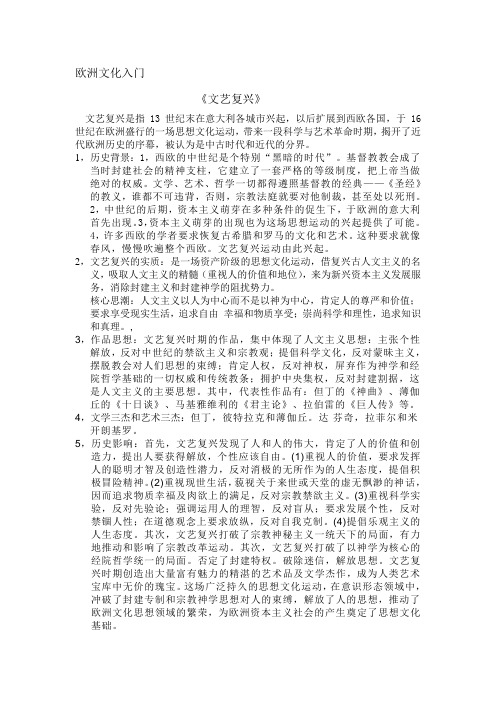
欧洲文化入门《文艺复兴》文艺复兴是指13世纪末在意大利各城市兴起,以后扩展到西欧各国,于16世纪在欧洲盛行的一场思想文化运动,带来一段科学与艺术革命时期,揭开了近代欧洲历史的序幕,被认为是中古时代和近代的分界。
1,历史背景:1,西欧的中世纪是个特别“黑暗的时代”。
基督教教会成了当时封建社会的精神支柱,它建立了一套严格的等级制度,把上帝当做绝对的权威。
文学、艺术、哲学一切都得遵照基督教的经典——《圣经》的教义,谁都不可违背,否则,宗教法庭就要对他制裁,甚至处以死刑。
2,中世纪的后期,资本主义萌芽在多种条件的促生下,于欧洲的意大利首先出现。
3,资本主义萌芽的出现也为这场思想运动的兴起提供了可能。
4,许多西欧的学者要求恢复古希腊和罗马的文化和艺术。
这种要求就像春风,慢慢吹遍整个西欧。
文艺复兴运动由此兴起。
2,文艺复兴的实质:是一场资产阶级的思想文化运动,借复兴古人文主义的名义,吸取人文主义的精髓(重视人的价值和地位),来为新兴资本主义发展服务,消除封建主义和封建神学的阻扰势力。
核心思潮:人文主义以人为中心而不是以神为中心,肯定人的尊严和价值;要求享受现实生活,追求自由幸福和物质享受;崇尚科学和理性,追求知识和真理。
,3,作品思想:文艺复兴时期的作品,集中体现了人文主义思想:主张个性解放,反对中世纪的禁欲主义和宗教观;提倡科学文化,反对蒙昧主义,摆脱教会对人们思想的束缚;肯定人权,反对神权,屏弃作为神学和经院哲学基础的一切权威和传统教条;拥护中央集权,反对封建割据,这是人文主义的主要思想。
其中,代表性作品有:但丁的《神曲》、薄伽丘的《十日谈》、马基雅维利的《君主论》、拉伯雷的《巨人传》等。
4,文学三杰和艺术三杰:但丁,彼特拉克和薄伽丘。
达·芬奇,拉菲尔和米开朗基罗。
5,历史影响:首先,文艺复兴发现了人和人的伟大,肯定了人的价值和创造力,提出人要获得解放,个性应该自由。
(1)重视人的价值,要求发挥人的聪明才智及创造性潜力,反对消极的无所作为的人生态度,提倡积极冒险精神。
欧洲文化入门复习题答案
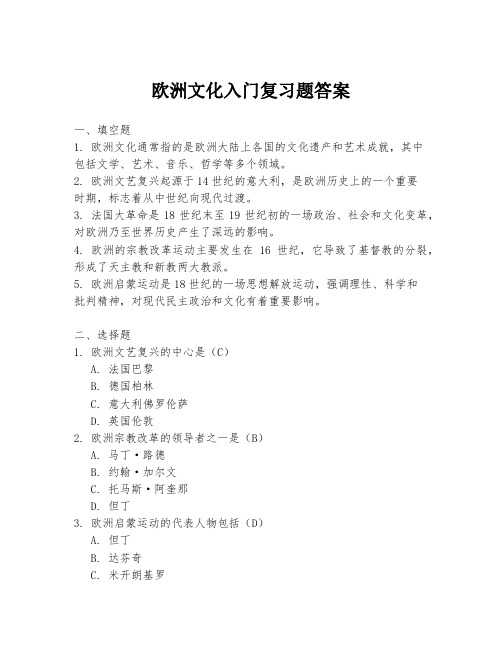
欧洲文化入门复习题答案一、填空题1. 欧洲文化通常指的是欧洲大陆上各国的文化遗产和艺术成就,其中包括文学、艺术、音乐、哲学等多个领域。
2. 欧洲文艺复兴起源于14世纪的意大利,是欧洲历史上的一个重要时期,标志着从中世纪向现代过渡。
3. 法国大革命是18世纪末至19世纪初的一场政治、社会和文化变革,对欧洲乃至世界历史产生了深远的影响。
4. 欧洲的宗教改革运动主要发生在16世纪,它导致了基督教的分裂,形成了天主教和新教两大教派。
5. 欧洲启蒙运动是18世纪的一场思想解放运动,强调理性、科学和批判精神,对现代民主政治和文化有着重要影响。
二、选择题1. 欧洲文艺复兴的中心是(C)A. 法国巴黎B. 德国柏林C. 意大利佛罗伦萨D. 英国伦敦2. 欧洲宗教改革的领导者之一是(B)A. 马丁·路德B. 约翰·加尔文C. 托马斯·阿奎那D. 但丁3. 欧洲启蒙运动的代表人物包括(D)A. 但丁B. 达芬奇C. 米开朗基罗D. 伏尔泰4. 法国大革命的标志性事件是(A)A. 巴士底狱的攻占B. 拿破仑的加冕C. 法国的君主立宪制D. 法国的共和制确立三、简答题1. 简述欧洲文艺复兴的特点。
答:欧洲文艺复兴的特点包括对古典文化的复兴,对人文主义的强调,艺术和科学领域的创新,以及对个人主义的推崇。
这一时期的艺术家和学者开始重视人的价值和能力,探索自然和人类社会的真实面貌。
2. 欧洲宗教改革对欧洲社会产生了哪些影响?答:欧洲宗教改革对欧洲社会产生了深远的影响,包括促进了宗教多元化,引发了一系列的宗教战争,推动了民族国家的形成,以及促进了教育和文化的普及。
四、论述题1. 论述欧洲启蒙运动对现代民主政治和文化的影响。
答:欧洲启蒙运动对现代民主政治和文化产生了深远的影响。
它提倡理性思考和科学方法,反对迷信和盲从,为现代民主政治的建立提供了思想基础。
同时,启蒙运动还强调个人自由和权利,推动了法律和制度的改革,促进了社会的进步和文明的发展。
《欧洲文化入门》课程介绍
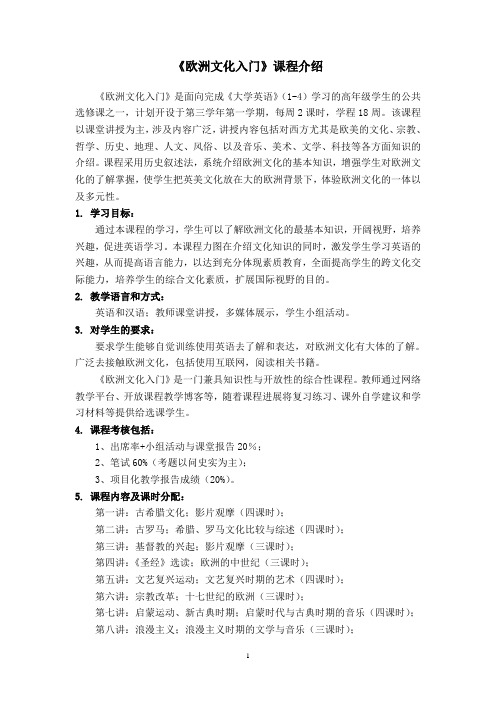
《欧洲文化入门》课程介绍《欧洲文化入门》是面向完成《大学英语》(1-4)学习的高年级学生的公共选修课之一,计划开设于第三学年第一学期,每周2课时,学程18周。
该课程以课堂讲授为主,涉及内容广泛,讲授内容包括对西方尤其是欧美的文化、宗教、哲学、历史、地理、人文、风俗、以及音乐、美术、文学、科技等各方面知识的介绍。
课程采用历史叙述法,系统介绍欧洲文化的基本知识,增强学生对欧洲文化的了解掌握,使学生把英美文化放在大的欧洲背景下,体验欧洲文化的一体以及多元性。
1. 学习目标:通过本课程的学习,学生可以了解欧洲文化的最基本知识,开阔视野,培养兴趣,促进英语学习。
本课程力图在介绍文化知识的同时,激发学生学习英语的兴趣,从而提高语言能力,以达到充分体现素质教育,全面提高学生的跨文化交际能力,培养学生的综合文化素质,扩展国际视野的目的。
2. 教学语言和方式:英语和汉语;教师课堂讲授,多媒体展示,学生小组活动。
3. 对学生的要求:要求学生能够自觉训练使用英语去了解和表达,对欧洲文化有大体的了解。
广泛去接触欧洲文化,包括使用互联网,阅读相关书籍。
《欧洲文化入门》是一门兼具知识性与开放性的综合性课程。
教师通过网络教学平台、开放课程教学博客等,随着课程进展将复习练习、课外自学建议和学习材料等提供给选课学生。
4. 课程考核包括:1、出席率+小组活动与课堂报告20%;2、笔试60%(考题以问史实为主);3、项目化教学报告成绩(20%)。
5. 课程内容及课时分配:第一讲:古希腊文化;影片观摩(四课时);第二讲:古罗马;希腊、罗马文化比较与综述(四课时);第三讲:基督教的兴起;影片观摩(三课时);第四讲:《圣经》选读;欧洲的中世纪(三课时);第五讲:文艺复兴运动;文艺复兴时期的艺术(四课时);第六讲:宗教改革;十七世纪的欧洲(三课时);第七讲:启蒙运动、新古典时期;启蒙时代与古典时期的音乐(四课时);第八讲:浪漫主义;浪漫主义时期的文学与音乐(三课时);第九讲:现实主义;影片观摩(三课时);第十讲:二十世纪的欧洲与现代主义;现代美术作品观摩(三课时);6. 教材王佐良等《欧洲文化入门》,外语教学与研究出版社,1992。
《欧洲文化入门》外国百科知识梳理
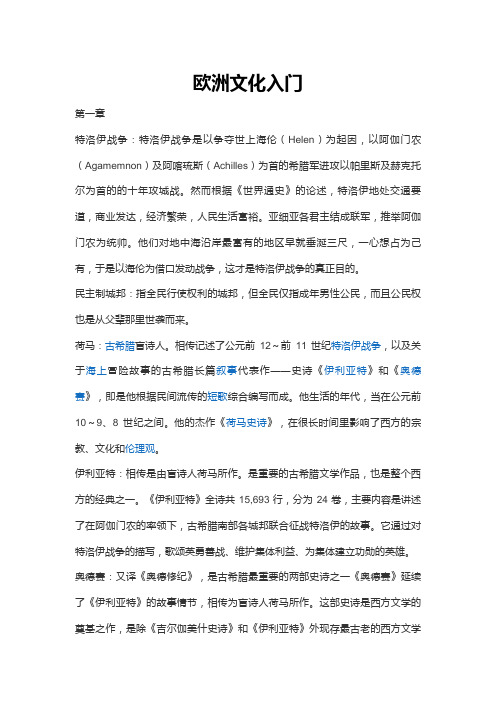
欧洲文化入门第一章特洛伊战争:特洛伊战争是以争夺世上海伦(Helen)为起因,以阿伽门农(Agamemnon)及阿喀琉斯(Achilles)为首的希腊军进攻以帕里斯及赫克托尔为首的的十年攻城战。
然而根据《世界通史》的论述,特洛伊地处交通要道,商业发达,经济繁荣,人民生活富裕。
亚细亚各君主结成联军,推举阿伽门农为统帅。
他们对地中海沿岸最富有的地区早就垂涎三尺,一心想占为己有,于是以海伦为借口发动战争,这才是特洛伊战争的真正目的。
民主制城邦:指全民行使权利的城邦,但全民仅指成年男性公民,而且公民权也是从父辈那里世袭而来。
荷马:古希腊盲诗人。
相传记述了公元前12~前11世纪特洛伊战争,以及关于海上冒险故事的古希腊长篇叙事代表作——史诗《伊利亚特》和《奥德赛》,即是他根据民间流传的短歌综合编写而成。
他生活的年代,当在公元前10~9、8世纪之间。
他的杰作《荷马史诗》,在很长时间里影响了西方的宗教、文化和伦理观。
伊利亚特:相传是由盲诗人荷马所作。
是重要的古希腊文学作品,也是整个西方的经典之一。
《伊利亚特》全诗共15,693行,分为24卷,主要内容是讲述了在阿伽门农的率领下,古希腊南部各城邦联合征战特洛伊的故事。
它通过对特洛伊战争的描写,歌颂英勇善战、维护集体利益、为集体建立功勋的英雄。
奥德赛:又译《奥德修纪》,是古希腊最重要的两部史诗之一《奥德赛》延续了《伊利亚特》的故事情节,相传为盲诗人荷马所作。
这部史诗是西方文学的奠基之作,是除《吉尔伽美什史诗》和《伊利亚特》外现存最古老的西方文学作品。
讲述了奥德修斯在特洛伊战争结束后返回家乡绮色佳岛的故事,书中讲述了奥德修斯在漫长的海上航行中的种种冒险经历,以及最终如何与忠实的妻子泊涅罗泊重新团聚的故事。
荷马史诗:《荷马史诗》相传是由古希腊盲诗人荷马创作的两部长篇史诗——《伊利亚特》和《奥德赛》的统称,是他根据民间流传的短歌综合编写而成。
《荷马史诗》以扬抑格六音部写成,集古希腊口述文学之大成,是古希腊最伟大的作品,也是西方文学中最伟大的作品。
欧洲文化入门(精品英文PPT课件)
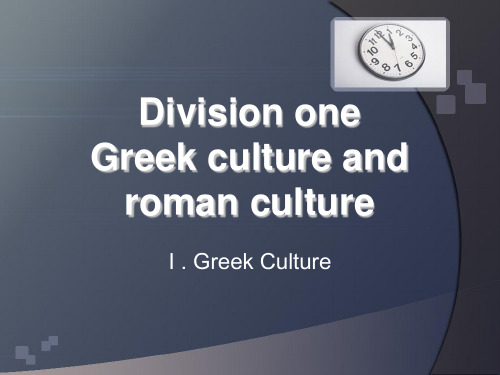
Division one Greek culture and roman culture
I . Greek Culture
Group one
• Leader:胡锦璞 • Members:孙京、杨建勋、赵元硕、段娟娟
• • • • •
Part 1-3 Part 4-6 Part 7 Part 8 Part 9
胡锦璞 赵元硕 段娟娟 杨建勋 孙 京
1、The Historical Background
• TIME: around 1200B.C. • Establishment : after the war between Greece and Troy. • Cultural Significance: mark by the successful repulse of the Persian invasion . • Spread : Alexander and his armies conquered large areas of Europe Asia and Africa. • End: it was conquered by the Romans
• The Histories — his masterpiece and the only work he is known to have produced — is a record of his "inquiry" , being an investigation of the origins of the Greco-Persian Wars and including a wealth of geographical and ethnographical information. Although some of his stories were not completely accurate, he claimed that he was reporting only what had been told to him. Little is known of his personal history since ancient records are scanty, contradictory and often fanciful.
欧洲文化入门教学设计

欧洲文化入门教学设计介绍欧洲文化是西方文化中最有代表性的一部分,具有丰富多彩、历史悠久的特点。
随着国际化和全球化的发展,了解欧洲文化已经成为现代人的必备知识之一。
因此,针对初学者,设计一份欧洲文化入门教学计划,将深受欢迎。
教学目的通过本教学计划,学生能够理解欧洲文化的基本特点和历史脉络,掌握一些欧洲国家的文化背景和一些词汇,提高自身跨文化沟通的能力和文化素养,为更深入的学习欧洲文化打下基础。
教学内容欧洲文化的基本概念概括介绍欧洲文化的基本定义,包括欧洲文化的种类、特点和历史背景。
欧洲文化的代表性国家介绍介绍欧洲文化的代表性国家,如英国、法国、意大利等,包括国家历史、文化背景、地理和人口情况等方面的简略介绍。
英语单词介绍涉及欧洲文化的英语单词,如“Bistro”,“Gondola”等。
学生可以通过记忆这些单词,扩大自身的英语词汇,增强跨文化交流的语言能力。
欧洲文化的艺术和文学作品介绍介绍欧洲文化的代表性艺术和文学作品,如《战争与和平》、《蒂姆·波特》、《摇滚乐队》等,分析作品的背景、主题和艺术特色。
教学方法授课方式教师采取讲解和互动问答的方式,鼓励学生就教材中涉及的问题开展讨论。
词汇与语音练习针对涉及到的英语单词,需要学生进行词汇和语音练习,加深学生的词汇记忆。
案例分析在介绍各个国家和艺术、文学作品时,需要通过历史和具体案例,引导学生积极思考,理解欧洲文化的核心价值。
教学评估学生需要完成书面作业和课上提问和互动讨论等,通过考核,评估学生对欧洲文化的理解和运用。
参考文献1.《西方文化概论》,冯一平,社会科学文献出版社2.《英语单词词典》,Oxford Dictionary3.《欧洲文化推荐读本》,洛阳市人民出版社以上是针对欧洲文化入门教学设计的一份简要计划,希望能够对初学者提供一些有用的参考和帮助。
欧洲文化入门期末总结
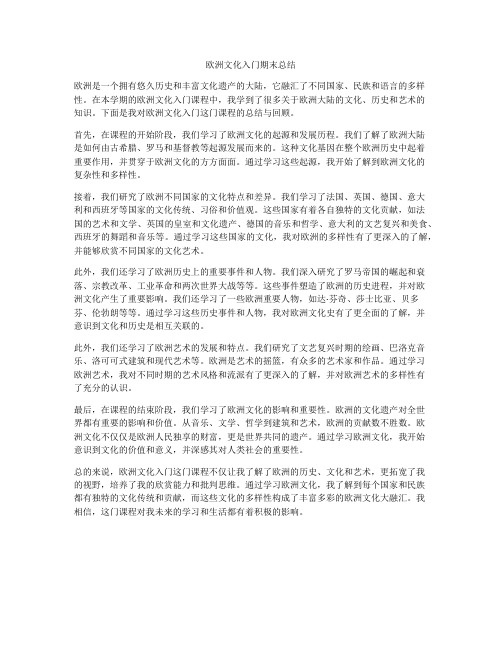
欧洲文化入门期末总结欧洲是一个拥有悠久历史和丰富文化遗产的大陆,它融汇了不同国家、民族和语言的多样性。
在本学期的欧洲文化入门课程中,我学到了很多关于欧洲大陆的文化、历史和艺术的知识。
下面是我对欧洲文化入门这门课程的总结与回顾。
首先,在课程的开始阶段,我们学习了欧洲文化的起源和发展历程。
我们了解了欧洲大陆是如何由古希腊、罗马和基督教等起源发展而来的。
这种文化基因在整个欧洲历史中起着重要作用,并贯穿于欧洲文化的方方面面。
通过学习这些起源,我开始了解到欧洲文化的复杂性和多样性。
接着,我们研究了欧洲不同国家的文化特点和差异。
我们学习了法国、英国、德国、意大利和西班牙等国家的文化传统、习俗和价值观。
这些国家有着各自独特的文化贡献,如法国的艺术和文学、英国的皇室和文化遗产、德国的音乐和哲学、意大利的文艺复兴和美食、西班牙的舞蹈和音乐等。
通过学习这些国家的文化,我对欧洲的多样性有了更深入的了解,并能够欣赏不同国家的文化艺术。
此外,我们还学习了欧洲历史上的重要事件和人物。
我们深入研究了罗马帝国的崛起和衰落、宗教改革、工业革命和两次世界大战等等。
这些事件塑造了欧洲的历史进程,并对欧洲文化产生了重要影响。
我们还学习了一些欧洲重要人物,如达·芬奇、莎士比亚、贝多芬、伦勃朗等等。
通过学习这些历史事件和人物,我对欧洲文化史有了更全面的了解,并意识到文化和历史是相互关联的。
此外,我们还学习了欧洲艺术的发展和特点。
我们研究了文艺复兴时期的绘画、巴洛克音乐、洛可可式建筑和现代艺术等。
欧洲是艺术的摇篮,有众多的艺术家和作品。
通过学习欧洲艺术,我对不同时期的艺术风格和流派有了更深入的了解,并对欧洲艺术的多样性有了充分的认识。
最后,在课程的结束阶段,我们学习了欧洲文化的影响和重要性。
欧洲的文化遗产对全世界都有重要的影响和价值。
从音乐、文学、哲学到建筑和艺术,欧洲的贡献数不胜数。
欧洲文化不仅仅是欧洲人民独享的财富,更是世界共同的遗产。
- 1、下载文档前请自行甄别文档内容的完整性,平台不提供额外的编辑、内容补充、找答案等附加服务。
- 2、"仅部分预览"的文档,不可在线预览部分如存在完整性等问题,可反馈申请退款(可完整预览的文档不适用该条件!)。
- 3、如文档侵犯您的权益,请联系客服反馈,我们会尽快为您处理(人工客服工作时间:9:00-18:30)。
❖ In 1648, by the terms of the Treaty of Westphalia, which ended the Thirty Years’ War, the principle of national sovereignty was firmly established in the West: By that principle, each European state would exercise independent and supreme authority over its own territories and inhabitants.
While the seventeenth century was a period of religious turbulence and heightened spirituality, it was also an age of scientific discovery and development. The Scientific Revolution that occurred in Europe between approximately 1600 and 1750 was not entirely sudden, nor were its foundations exclusively European. It owed much to a long history of science and technology that reached back to ancient Egypt, China, and Islam, to the construction of pyramids and cathedrals, the formulation of Euclidean geometry, and the invention of the windmill, the magnetic compass, and the printing press.
❖ The sciences advanced in logical progression through modern history: first a breakthrough in physics and mathematics in the 17th century, followed by rapid developments in the field of chemistry in the 18th century and then advances in biology in the 19th century and psychology in the 20th century.
❖ In the economic arena, the prosperity of the sixteenth century was followed by marked decline in the seventeenth. Nevertheless, after 1660, commercial capitalism and the production of manufactured goods flourished in the West, where economic growth was tied to a pattern of global commerce.
❖ In the West, the years between 1600 and 1750 wБайду номын сангаасre closely associated with a style known as “the baroque” characterized by dramatic expression, theatrical spectacle, and spatial grandeur, the baroque became the hallmark of an age of exuberant活跃的 expansion. The style also reflected the new, dynamic view of the universe as set forth by proponents拥护者 of the Scientific Revolution. The baroque encompassed various phases: In Italy, it mirrored the intensely religious mood of the Catholic Reformation; in Northern Europe, it reflected the intimate spirit of Protestant devotionalism as well as the reliance on sensory experience associated with the New Science.
欧洲文化入门
❖ The period between approximately 1600 and 1800 was an age of contradictions. In Western Europe, deeply felt, even mystical religious sentiment vied争夺 with the rise of science and rational methods of scientific investigation. Newly developed theories of constitutional government 立宪 政体contended with firmly entrenched 确 立的claims to divine right among “absolute” rulers—monarchs who recognized no legal limitations to their authority.
